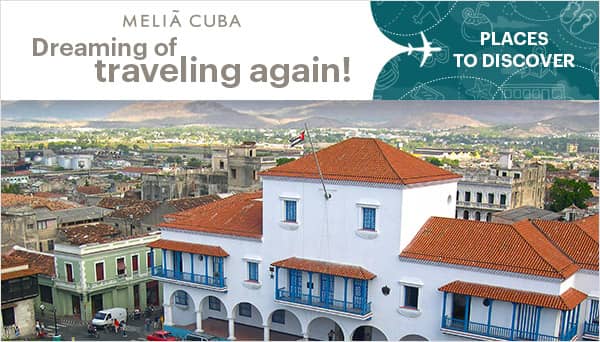If we had to recommend a Cuban city to represent the soul of the island, that would be, without a doubt, Santiago. Many nationals who were born in other regions of Cuba might disagree, but that’s a different story. Today we want to present a route in the so-called “Hero City”; a path you must take on foot not to miss the best details. Imagine you take a hat, a camera and let’s go!
We will start at the corner where three important Santiago avenues intersect: Los Libertadores, Desfiles and Avenida de las Américas. Look around you … we are in the Monumental Complex “General Antonio Maceo”, the famous Plaza de la Revolución in Santiago. This esplanade hosts massive events in the city, and its design is inspired by the Baraguá Protest, an episode of the Wars of Independence that marked the rebellious character of the Cubans. The figure on horseback is Maceo himself, the protagonist of the said Protest and whose many military feats are celebrated and remembered by all Cubans. Around it you will see 23 gigantic machetes, which recall the main combat weapon of the mambises during the wars of independence; their number alludes to the resumption of the confrontations after the Protest that we mentioned before – on March 23, 1878-.
Let’s leave the Plaza and follow Avenida de las Américas heading south. We will pass through the sports stadium “Guillermón Moncada” and the Universidad de Oriente “Julio Antonio Mella”, until we reach Ferreiro Park. Let’s take a break here: the trees are copious being a good place to look at – and admire – the cheerful people of Santiago come and go, without rushing, on their daily tasks. Ready again? We turn right to now walk through Victoriano de Garzón avenue, or simply “Garzón”, as it is better known.
https://youtu.be/Mu-11E3XRbU
If you are bold and like street food, you are in the right place. Numerous vendors of the famous “Caney” fruits circulate in the area: mangoes, mameyes, “nísperos”, “caimitos”, “chirimoyas”. In shops and kiosks, you will find these same delicacies turned into very cold juices, and we know the case of a certain traveler who, in love with a legendary coconut smoothie that she tasted, made an express request to the seller to fill her a liter and a half container. There are not only fruits to choose from: we also invite you to try various types of ice cream, oyster cocktails, “Cuban-style” pizzas and churros.
Let’s continue, now with a stimulating proposal. The quality of Cuban rums is renowned worlwide. Although perhaps the most famous of rings a bell – the Havana Club – but if you are in Santiago de Cuba you are banned from mentioning it. And there’s a reason for it! This is the land that manufactures the best liqueurs on the island, such as Santiago, Caney, Varadero, Edmundo Dantés and Paticruzado. You can buy them all in the shops and markets along the avenue, to take another piece of Cuba with you. With energy, because the climb is somewhat steep, let’s get to the Plaza de Marte. Used as a training ground for the soldiers of the old Spanish metropolis, it remains today as a spacious park with six gardens, pergolas and sculptures that commemorate various heroes of the city. In the center, a column crowned by a Phrygian cap remembers all those who fought for Cuban independence during the 19th century. This square marks the border between the modern and the ancient city; and just now we will cross it to reach the most colonial area of Santiago. We will go down a very popular street “José Antonio Saco”. Do you know it? What if we say: “Enrramadas”? Symbol of commercial and social life in this city, its excellent state of preservation and the buildings that surround it will be the perfect stage for photos, videos and memories. It is an itinerary only for pedestrians, although a tram circulated here at the beginning of the last century. Stop and admire places like the Heredia Theater, the Garden of the Holy Spirit … if you want to deviate a little, ask for “Casa de la Trova”, “El Patio de Los Dos Abuelos” … and come back soon, we are almost done. Let’s move a little to enter, through one of its corners, the Parque Céspedes. The classic images of Santiago where the cathedral and the City Hall shine, were taken here.
Indeed, the first thing that attracts attention is the imposing church whose initial construction dates back to 1522, and which since 1958 has been a National Monument of Cuba. Look also at the headquarters of the Municipal Government, which occupies a building that witnessed various events in the revolutionary process; and which two-story house, with a tile roof and wood-grated balconies, was the residence of Diego Velázquez and is recognized as the oldest home on the entire island. Today it works as a Museum of Cuban Heritage. There are still many things to see in Santiago. But you have plan the good times to live them better, so we will end for now. If you enjoyed the ride, come back! Combine our route with your interests and create your own tour! The capital of Eastern Cuba, the city that grew between the sea and the mountains, never disappoints.

